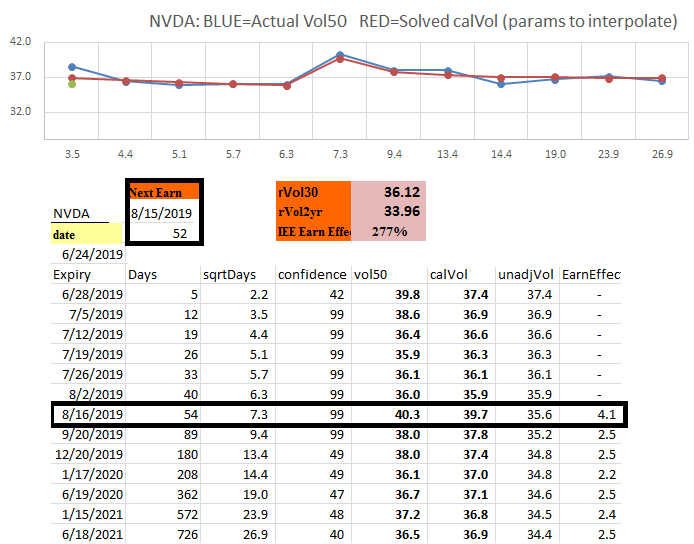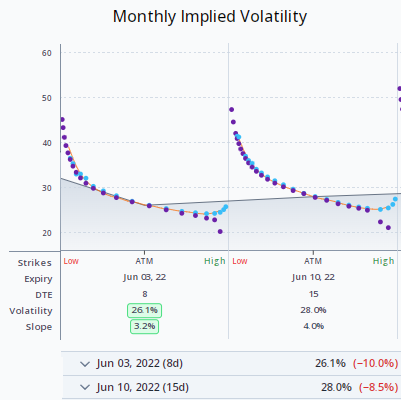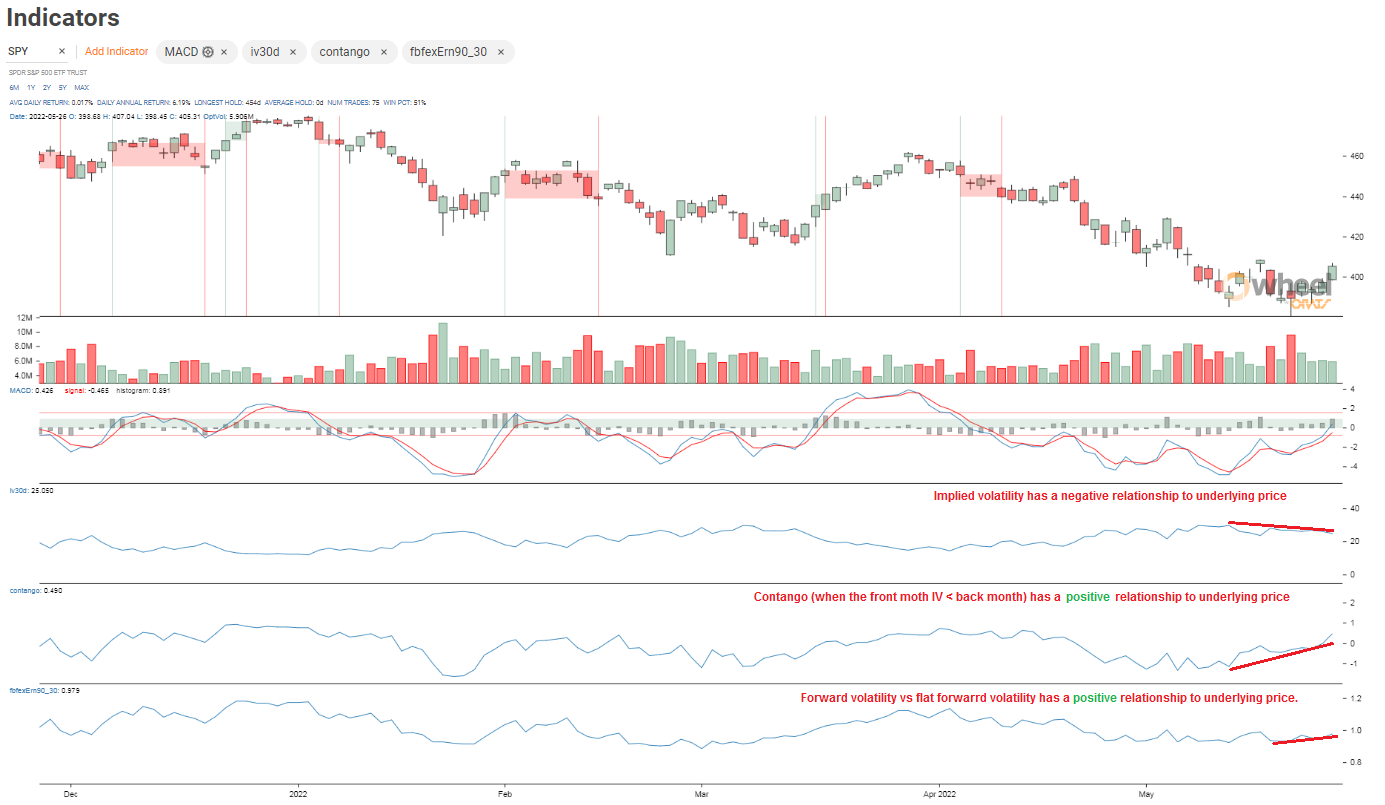Indicators
Tuesday, June 25th 2019
Implied Volatility Term Structure's Three Parameters
The implied volatility term structure can be summarized into 1) the 30 day IV 2) the 2 year IV and 3) the implied earnings effect.
Summary
The implied volatility term structure can be summarized into the 30 day IV, the 2 year IV, and the implied earnings effect. These three parameters are used to summarize most of the term structure. The earnings effect is the percentage by which a stock will move on an earnings announcement. Other parameters that apply to term structure include seasonal term adjustments and short-term IV ATM slope, and other parameters that apply to the monthly strike IV skew, such as slope, derivative, additional call/put wing amounts, and residual yield.
Important information on a ticker is found in the implied volatility (IV) term-structure parameters. The three most important parameters are:
- the 30 day constant maturity implied volatility
- the 2 year constant maturity implied volatility
- the implied earnings effect
Using these three parameters most of the term structure can be summarized.
Let's take an example from today, 6/24/2019, NVDA.

The steps to summarizing the term structure are to:
- Gather the at-the-money (ATM) IVs for each month. ORATS Money API call brings in the 'vol50', the smoothed volatility at the 50 delta in the picture above.
- Take the square root of the days to expiration
- Find the earnings month
- Set up a time skew that draws a curve from the 30 day IV and 2 year IV. ORATS uses a proprietary method but there are models on the web or any curve can be tried. Above the column 'unadjVol' corresponds to this skew calculation.
- Calculate the earnings effect and add to the expirations that occur after the next earnings announcement as in 'EarnEffect' above. Add these effects to the 'unadjVol' to get the 'calVol' or calculated vol.
- Simultaneously solve for the three parameters to the skew that minimizes the difference between the actual volatilities 'vol50' and the calculated volatilities in 'calVol'.
For NVDA today we would say the the 30 day implied volatility ex-earnings is 36.12% and the 2-year IV is 33.96%, and the implied earnings effect is 277%. A way to think about the implied earnings effect is that on the earnings announcement, the stock will move at 277% of its implied volatility.
There are other parameters that apply to term structure like seasonal term adjustments and short-term IV ATM slope (we call Contango), and other parameters that apply to the monthly strike IV skew, such as slope (skew), derivative (kurtosis), additional call/put wing amounts, and residual yield but these are not as important as the big three above and are the subject of other posts.
Moreover, there are more constant maturity calculations that are provided in the ORATS Data API, but the point of this exercise is to use as few parameters as possible to summarize the implied volatilities, with a tip of the hat to Ockham's razor.
References:
Disclaimer:
The opinions and ideas presented herein are for informational and educational purposes only and should not be construed to represent trading or investment advice tailored to your investment objectives. You should not rely solely on any content herein and we strongly encourage you to discuss any trades or investments with your broker or investment adviser, prior to execution. None of the information contained herein constitutes a recommendation that any particular security, portfolio, transaction, or investment strategy is suitable for any specific person. Option trading and investing involves risk and is not suitable for all investors.
All opinions are based upon information and systems considered reliable, but we do not warrant the completeness or accuracy, and such information should not be relied upon as such. We are under no obligation to update or correct any information herein. All statements and opinions are subject to change without notice.
Past performance is not indicative of future results. We do not, will not and cannot guarantee any specific outcome or profit. All traders and investors must be aware of the real risk of loss in following any strategy or investment discussed herein.
Owners, employees, directors, shareholders, officers, agents or representatives of ORATS may have interests or positions in securities of any company profiled herein. Specifically, such individuals or entities may buy or sell positions, and may or may not follow the information provided herein. Some or all of the positions may have been acquired prior to the publication of such information, and such positions may increase or decrease at any time. Any opinions expressed and/or information are statements of judgment as of the date of publication only.
Day trading, short term trading, options trading, and futures trading are extremely risky undertakings. They generally are not appropriate for someone with limited capital, little or no trading experience, and/ or a low tolerance for risk. Never execute a trade unless you can afford to and are prepared to lose your entire investment. In addition, certain trades may result in a loss greater than your entire investment. Always perform your own due diligence and, as appropriate, make informed decisions with the help of a licensed financial professional.
Commissions, fees and other costs associated with investing or trading may vary from broker to broker. All investors and traders are advised to speak with their stock broker or investment adviser about these costs. Be aware that certain trades that may be profitable for some may not be profitable for others, after taking into account these costs. In certain markets, investors and traders may not always be able to buy or sell a position at the price discussed, and consequently not be able to take advantage of certain trades discussed herein.
Be sure to read the OCCs Characteristics and Risks of Standardized Options to learn more about options trading.
Related Posts



